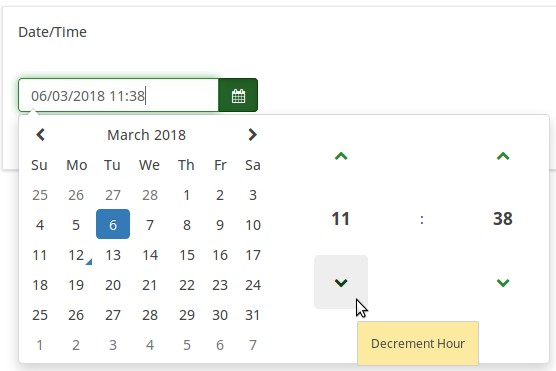Tipologie di domande
From LimeSurvey Manual
Informazioni generali
In questa pagina verrà fatta una panoramica generale su tutte le tipologie di domande presenti in LimeSurvey, per poi passare ai dettagli di ciascuna tipologia.
Nel pacchetto di installazione di LimeSurvey è presente inoltre un esempio di indagine che contiene tutti i tipi di domande. L'esempio si trova nella cartella "/docs/demosurveys", è poi possibile importarlo e provarlo!
Sotto-domande
Il significato di sotto-domande è stato introdotto dalla versione di LimeSurvey 1.90 e successive. Tuttavia le sottodomande esistevano anche nelle versioni precedenti anche se denominate in modo diverso e spesso nascoste dalle Label sets. Con la versione 1.90 la loro definizione diventa più chiara e intuitiva.
Cosa sono le sottodomande
Solitamente ad una domanda corrisponde un gruppo di risposte, ma in alcuni casi (ad es. per le domande della tipologia "Array" o matrice) una domanda contiene al suo interno più sottodomande, alle quali l'intervistato dovrà rispondere (spesso utilizzando una lista predifinita di risposte o una scala di valori).
La tipologia di domanda più complessa è la "Scelta (testi)", in cui l'intervistato deve inserire una risposta per ciascuna combinazione della matrice visualizzata. In questi casi ciascun valore costituisce una risposta e la domanda sarà struttura con due liste di sotto-domande (la prima presente nelle righe e la seconda nelle colonne)
Formattazione delle domande
E' possibile creare un layout/formattazione generale di base per le domande utilizzando i files CSS. Per ulteriori informazioni consultare Stile di formattazione con CSS
Tipologie di domande
Arrays o Matrici
La tipologia "Array" (spesso definita come "Array flessibile") comprende diverse versioni che verranno esposte nel dettaglio in seguito. Grazie a questa tipologia, la domanda verrà visualizzata come una matrice in cui: -le righe corrispondono alle sottodomande -le colonne corrispondono alle risposte selezionabili. In questi casi la domanda potrà contenere un quesito specifico oppure guidare l'utente nella compilazione.
In termini di output (file con le risposte degli intervistati) verrà creata una variabile/colonna per ciascuna sottodomanda, alla stregua delle domande di tipo "Elenco (Pulsanti radio)".
Oltre alle tipologie più flessibili, come "Array","Array (numeri)" e "Scelta (testi)", LimeSurvey contiene una serie di matrici predefinite che semplicano la creazione dell'indagine.
Array
An array allows you to create a set of subquestions. Each of them uses the same set of answer options. For example, you can use this question type when you need feedback on several aspects of a particular product.
Find out more about the Array question type...
Scelta (punteggio 1-5)
It is an array type that is prefilled with answer choices. An 1 to 5 scale is used. A "No answer" answer option is automatically added if the question is not mandatory.
Example: Array 5 point choice example.zip
Find out more about the 5 point choice Array question type...
Scelta (punteggio 1-10)
It is an array question type that is prefilled with answer choices on a 1 to 10 scale. A "No answer" answer option is automatically added if the question is not mandatory.
Example: Array 10 point choice example.zip
Find out more about the 10 point choice Array question type...
Scelta (Sì/No/Non so)
It is an array question type that is prefilled with the following answer choices: "Yes", "No", and "Uncertain". You can also add a "No answer" choice if the question is not mandatory.
Example: Array Yes No Uncertain Example.zip
Find out more about the Yes/No/Uncertain Array question type...
Scelta (Aumenta/Uguale/Diminuisce)
It is an array type that is prefilled with the following answer choices: "Increase", "Same", and "Decrease". A "No answer" answer option is automatically added if the question is set to be not mandatory.
Example: Array increase decrease example.zip
Find out more about the Increase/Same/Decrease Array question type...
Array per colonna
This question type is the same as an array, except the subquestion and answer axes are swapped.
Example: Array by column example.zip
Find out more about the Array by column question type...
Array con doppia scala
This question type provides two scales of answer options for each subquestion. A heading can be set for each scale from the question display options:
You can also set a special question attribute to use this question type with dropdown boxes:
Example 1: Dual Scale Example.zip
Example 2: Dual Scale Dropdown Example.zip
Find out more about the Array dual scale question type...
Array (Numeri)
This question types allows survey administrators to a create large arrays with numbered dropdown boxes with a set of subquestions on the "y-axis", and another set of subquestions on the "x-axis".

You can also set a special question attribute to use this question type with checkboxes:

Example 1: Example_Array_Numbers
Example 2: Example_Array_Numbers_Checkboxes
Find out more about the numbers Array question type...
Scelta (Testi)
The Array (Text) question type allows for an array of text boxes with a set of subquestions as the "y-axis", and another set of subquestions as the "x-axis".
Example: Array_Texts_Example_text.zip
Find out more about the text Array question type...
Domande con maschera
Due to a lack of better word we define all questions where the input of answers is predefined as 'mask questions'.
Data
This question type can be used to ask for a certain date, time or a combination of both date and time. The values can be selected by the participants either from a popup calendar or from dropdown boxes. Validation, minimum, and/or maximum dates can be chosen by the survey administrator. Various date and time formats are supported.
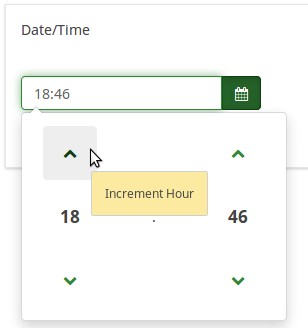
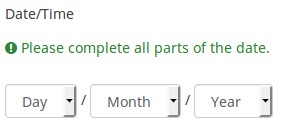
Example: Example_Date_Time.zip
Find out more about the Date question type...
Caricamento file
The file upload question type can be used to collect file(s) from a user in response to a question. For example, a company with employment opportunities could use this question type to request the candidate to submit/upload his or her updated CV, as well as any other scanned documents in the employment survey.
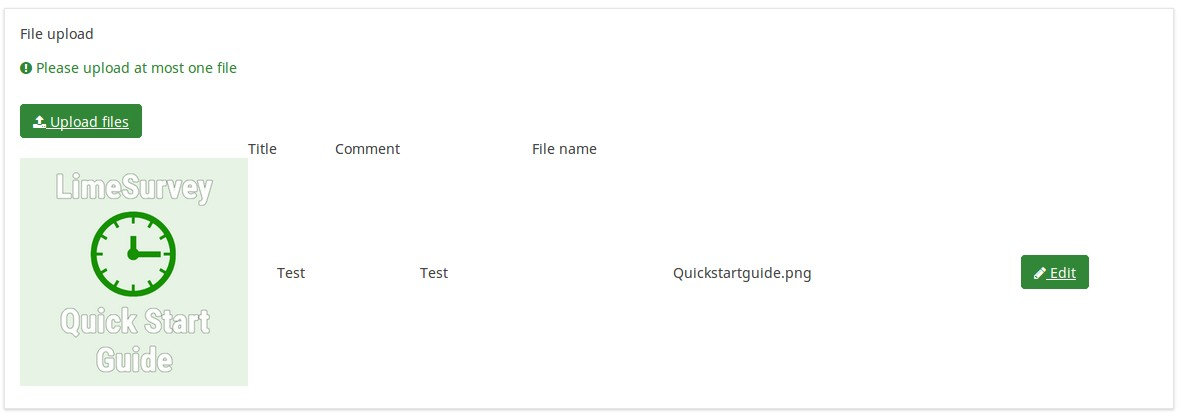
Example: File upload question type.zip
Find out more about the File upload question type...
Genere
This question type collects gender information ("Male" or "Female") from the respondents.

Example: Gender question type.zip
You may also add a "No answer" choice if the question is not mandatory.
Find out more about the Gender question type...
Cambio lingua
This question type allows the user to change the language of the survey. Users can choose from a dropdown list, the language in which they wish to have the survey questions displayed.
The dropdown list includes the base language (which is selected when the survey is created for the first time) and the additional ones (they can be edited from the general settings panel).
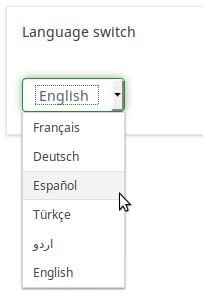
Example: Language switch question type
Find out more about the Language switch question type...
Inserimento numerico
This question types asks the survey participant to enter a single number.

Example: Question_example_numerical_input.zip.
Find out more about the Numerical Input question type...
Inserimento numerico multiplo
This question type is a variation of the "Numerical input" question type. It allows multiple text boxes to be created, each of them allowing the survey respondents to enter only numbers. Each text box corresponds to an subquestion, the subquestion text being the label for the input.

Example: Multiple_numerical_input_question_type_example.zip
Find out more about the Multiple numerical input question type...
Classifica
This question type allows you to present your survey participants a list of possible answers/options, which they may then rank according to their preferences.

Example: Question type ranking.zip.
Find out more about the Ranking question type...
Visualizza testo
This question type does not collect any input from the respondent. It just simply displays text. It can be used to provide further instructions or a design break in the survey.
Please note that you can write in the text of this question also html or javascript. In this way, you can use this question for other purposes.

Example: Text_display_example.zip
Find out more about the Text display question type...
Sì/No
Survey administrators can collect "Yes" or "No" responses from the respondents with the help of this question type.

Example: Yes/No question type example.
Find out more about the Yes/No question type...
Equazione


This question type lets the author create an equation (e.g., a calculation or tailored report) and save it in a database variable. Equations can use any syntax supported by ExpressionScript. If you are handling numeric values make sure that you use the advanced question setting "Numbers only" as explained below.
You may find below an example on how to use this question type:

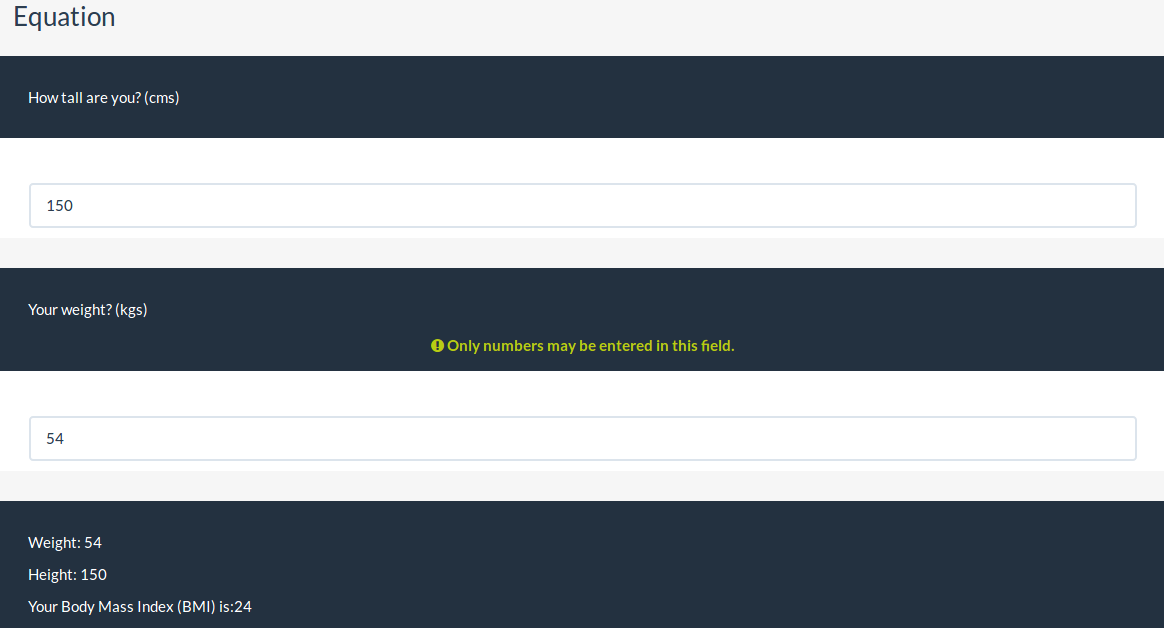
Example: Limesurvey_survey_BMIsample.lss.zip.
Find out more about the Equation question type...
Domande a scelta multipla
Sometimes you want the participan to mark more than one answer option in the same question; this is achieved using checkboxes.
Scelta multipla
This question type can collect input of multiple selections through checkboxes.
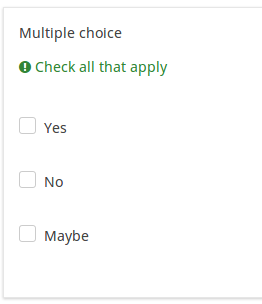
Example: Multiple choice question type example.
Find out more about the Multiple choice question type...
Scelta multipla con commenti
This question type can collect input of multiple selections through checkboxes, while allowing the user to provide additional comments.
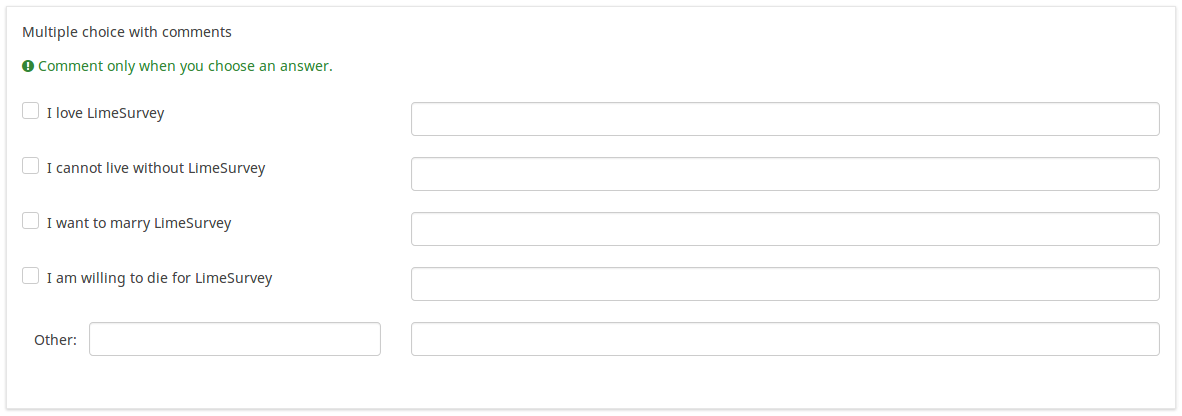
Example: Multiple choice with questions example.zip
Find out more about the Multiple choice with comments question type...
Domande a risposta singola
Single choice questions are those where the participant can only pick a single predefined answer option.
Attribuzione punteggio (1-5)
This question shows a horizontal 1 to 5 scale from where the survey participants can select a single answer option.
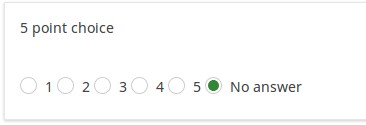
Example: Single choice question example.zip
Find out more about the 5 point choice question type...
Elenco (Menù Dropdown)
This question type collects input from a dropdown list menu. You can also create subcategories within this list by making use of the "Category separator" attribute.
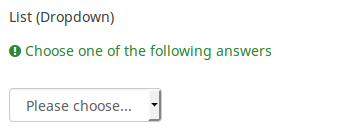
Example: List dropdown question.zip
Find out more about the List Dropdown question type...
Elenco (Pulsanti Radio)
This question type collects input from a list of radio buttons.
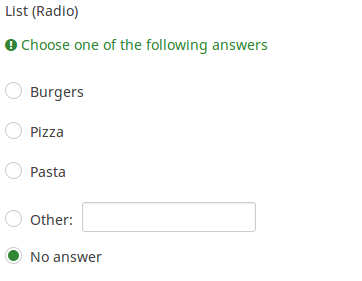
Example: List_radio_example.zip
Find out more about the List Radio question type...
Lista con commento
This question type displays a list of radio buttons, while allowing the participants to provide a additional comment with their submission.

Example: List_with_comment_example.zip
Find out more about the List with comment question type...
Domande con testi
LimeSurvey fornisce un numero predefinito di possibili variazioni relativamente alle domande di tipo testo. Ma ognuna di queste può essere ulteriormente definita utilizzando le Advanced question settings, che permettono, ad esempio, di limitare il numero di carateri consentiti oppure di impostare l'ampiezza del campo.
Inoltre il testo inserito nelle domande di tipo testo può essere validato con le espressioni regolari: Using regular expressions.
Testo breve
This question type collects a single line of text input.

Example: Short_free_text_question.zip
Find out more about the Short free text question type...
Testo lungo
This question type collects multiple lines of text input.

Example: Long_free_text_example.zip
Find out more about the Long free text question type...
Testo libero maxi
This question type collect multiple lines of text input, allowing more text to be typed in.

Example: Huge_free_text_example.zip
Find out more about the Huge free text question type...
Testo breve multiplo
This question type is a variation on the "Short Text" question type which allows more than one text entry per question. The user first defines the question and can then add additional text boxes by adding 'Answers'. Each answer becomes the label of the new text box.

Example: Multiple_short_text_example.zip
Find out more about the Multiple short text question type...










